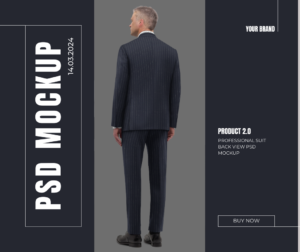A well-fitted suit is more than just a piece of clothing; it embodies style, confidence, and professionalism. Whether preparing for a wedding, a high-stakes business meeting, or simply wanting to look your best, understanding how to measure for a suit is pivotal. Accurate measurements ensure that your suit looks good and feels comfortable, giving you the confidence to tackle any occasion.
To achieve that perfect fit, it’s crucial to consider several aspects, such as shoulder width, chest circumference, waist, and inseam length. Additionally, paying attention to fabric choice, suit construction, and tailoring details can significantly impact the overall appearance and comfort of the suit. Consulting with a professional tailor can provide invaluable insights into what styles and cuts work best for your body type, ensuring you present yourself in the best possible light. Investing time & effort into finding a well-fitted suit will undeniably enhance your presence and leave a lasting impression.
Understanding the Basics of Suit Measurement

Before diving into the measurement process, it’s important to familiarize yourself with some common terms:
- Chest Size: The circumference of the torso at the widest point of the chest.
- Sleeve Length: The length from the shoulder seam to the wrist bone.
- Inseam: The length from the crotch to the bottom of the trouser leg.
- Waist: The circumference around the natural waistline.
- Hip: The circumference at the widest part of the hip area.
- Shoulder Width: The distance between the outer edge of one shoulder to the other.
Understanding these terms will make the measurement process smoother and ensure that you achieve a perfect fit.
Preparing for Measurement
To get accurate measurements, you must ensure you’re properly prepared. Here are some tips:
- What to Wear: Wear fitted clothing or undergarments that do not add bulk. Avoid loose or thick fabrics that can distort measurements.
- Tools Needed: Record your measurements using a soft measuring tape, a full-length mirror, & a notepad.
- Posture: Stand straight and relaxed while being measured. Slouching or stretching can result in inaccurate measurements.
DIY Suit Measurement
Measuring yourself at home can be a convenient and cost-effective way to get your suit measurements. Properly taking these measurements ensures a tailored fit that enhances your appearance. Follow these detailed step-by-step instructions:
Chest
- Stand upright with your arms resting at your sides. Wrap the measuring tape about the fullest part of your chest, just under your armpits.
- Ensure the tape is snug but not too tight to allow some movement. Ensure it is leveled around your chest and back. Note down the measurement.
Sleeve Length
- Place the start of the tape at the shoulder seam, which is the point where the shoulder meets the arm. Extend the tape down to your wrist bone.
- Slightly bend your elbow while measuring to account for natural arm movement in the suit jacket. Record the measurement accurately.
Waist
- Wrap the tape around your natural waistline, typically just above your belly button or the narrowest part of your torso.
- Keep the tape snug but comfortable, ensuring it is level all around. Write down the measurement.
Inseam
- Measure from the crotch down to the bottom of your ankle, along the inner leg.
- Ensure the tape follows the contour of your inner leg without any slack. Note the measurement accurately for a proper fit.
Shoulder Width
- Stand naturally and have someone help you if possible. Measure from the outer edge of one shoulder to the other, across the back.
- Keep the tape flat and taut, ensuring it follows the natural curve of your shoulders. Record the measurement.
Hip
- Wrap the measuring tape around the widest part of your hips, usually at the fullest part of your buttocks.
- Ensure the tape is even and snug but not too tight. Note down the measurement, ensuring it is level all around.
By carefully following these steps, you can ensure that your suit measurements are precise, leading to a well-fitted and comfortable suit.
Professional Suit Measurement
While DIY measurements can be convenient, getting measured by a professional tailor offers several significant advantages:
- Accuracy: Tailors have the expertise to ensure precise measurements, minimizing errors that can often occur with self-measurements. Their training and experience allow them to achieve a level of accuracy that is difficult to replicate at home.
- Fit Customization: Professionals can provide valuable insights on fit preferences and suggest adjustments for optimal comfort and style. They can recommend alterations that you might not have considered, which can drastically improve the overall look and feel of your clothing.
- Experience: Tailors can spot potential issues that may not be apparent to the untrained eye and correct them before the suit is made, ensuring a perfect fit. Their keen eye for detail & understanding of fabric behavior can prevent common pitfalls, ensuring that the final product fits well and drapes beautifully.
During a professional measurement session, expect the tailor to take multiple measurements, double-check for accuracy, and discuss your fit preferences in detail. They may ask about how you plan to use the garment, your posture, and any specific areas of concern you have. This thorough process ensures that every aspect of the fit is tailored to your needs, resulting in a garment that looks as good as it looks. Such personalized attention to detail can significantly elevate your overall appearance and comfort, so investing in professional tailoring is well worth it.
Common Mistakes to Avoid
Even a small measurement error can lead to an ill-fitting suit. Here are some common mistakes to watch out for:
- Incorrect Posture: Standing improperly can result in inaccurate measurements.
- Loose Measuring Tape: Ensure the tape measure is snug against your body without being too tight.
- Inconsistent Measurements: Take each measurement at least twice to ensure consistency.
- Ignoring Fit Preferences: Consider how you want your suit to fit—whether you prefer a slim fit, regular fit, or relaxed fit.
Avoiding these mistakes will help ensure your suit fits perfectly and looks great.
Conclusion
Accurate measurements are crucial for achieving the perfect fitting suit. Whether you measure yourself at home or enlist the help of a professional tailor, understanding the process and avoiding common mistakes will ensure that you look and feel your best. A well-fitted suit is an investment in your wardrobe and your confidence.
We hope this guide has provided you with valuable insights into suit measurement. If you found this helpful, please share it with friends or colleagues who might benefit from this information. Happy measuring!



No Comment! Be the first one.